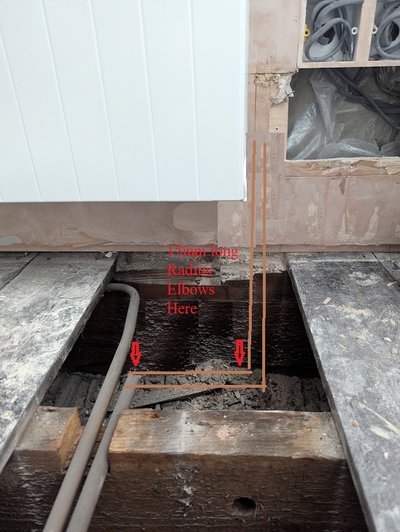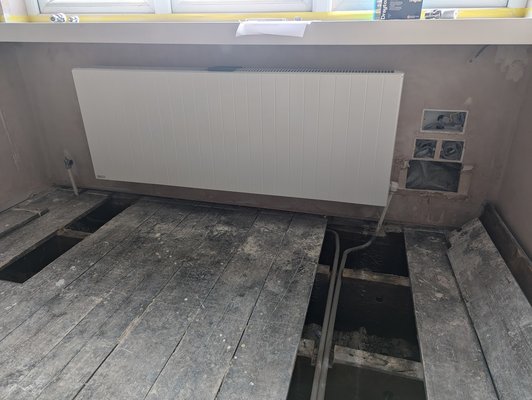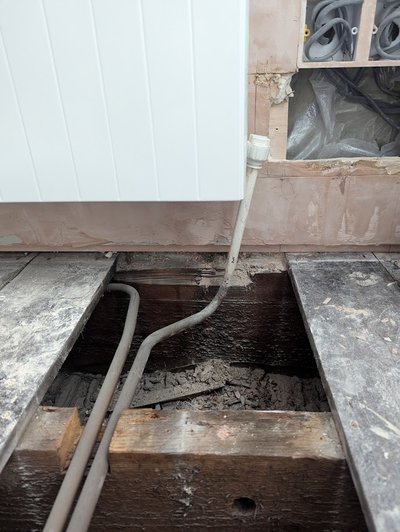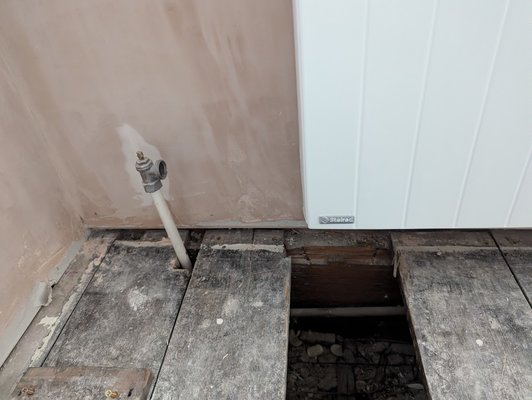You are using an out of date browser. It may not display this or other websites correctly.
You should upgrade or use an alternative browser.
You should upgrade or use an alternative browser.
DIY plumbing / central heating anyone?
- Thread starter hooblah
- Start date
Pigeon_Droppings2
Member
- Messages
- 6,434
- Location
- london
In that case do what you did and screw a bit of wood behind to hold the board...like you would do if you cut a hole in a ceiling.How exactly do you not leave a void behind?
If it's a socket cut in brick/block then I prefer to fill them.
So why do you say that I don't need to use scrim tape? All the youtubers seem to do it when patching holes.In that case do what you did and screw a bit of wood behind to hold the board...like you would do if you cut a hole in a ceiling.
If it's a socket cut in brick/block then I prefer to fill them.
Pigeon_Droppings2
Member
- Messages
- 6,434
- Location
- london
I find it causes hassle on repairs because it can end up showing through when you sand as the scrim sitting on the existing plaster needs to be covered. If you intend on plastering the whole wall then scrim tape is fine.So why do you say that I don't need to use scrim tape? All the youtubers seem to do it when patching holes.
Pigeon_Droppings2
Member
- Messages
- 6,434
- Location
- london
cut the hole slightly bigger (and square)...pop some wood behind and then screw the wood down to the existing plaster...then screw a repair piece of plasterboard over the wood and fill the lot.What would you do in the case of an inch diamter hole in the ceiling? Just smack a load of filler in there and hope for the best?
You can use 2 bits of wood if easier...or 1 with a screw in it (for a handle) thats how I do it...am sure others have their own tricks.
If you have a load of these then it's best to get them all ready for filling....then just mix up and fill all of them. It usually takes 2 or 3 coats to make a repair completely disappear.
No it's just the hole where the light fitting is/was. I'm contemplating not having a light in the centre of the ceiling, but I may decide later that I do want one. Need to fill the hole but make it so that it isn't awakward to reinstate. Not sure if screwing a piece of wood above is the best solution.
Pigeon_Droppings2
Member
- Messages
- 6,434
- Location
- london
In my own house when I did the refurb I fitted timbers between the joists for every light fitting. Just got fed up of messing about with screwing lights into plasterboard + we wanted the option of having heavier fittings if we decided to have them.
All depends on your situation and how much effort you want to put into it.
We have heavy lights...out kitchen light is a wine glass chandelier and I knew it was going to be heavy so belt and braces was the order of the day. Pendant lights I'd be less concerned.
All depends on your situation and how much effort you want to put into it.
We have heavy lights...out kitchen light is a wine glass chandelier and I knew it was going to be heavy so belt and braces was the order of the day. Pendant lights I'd be less concerned.
angellonewolf
Member
- Messages
- 8,760
- Location
- bristol england
ive a large ceiling fan but got to be mounted on a joistI'm nearing the end of the refurb now. I should probably start a separate thread tbh. I have considered putting in a ceiling fan but it;s not certain, I guess they weigh somewhere between 5 and 10kg.
A bit of timber above or behind is always a best solution, admittedly depending on size of hole, not always practical.No it's just the hole where the light fitting is/was. I'm contemplating not having a light in the centre of the ceiling, but I may decide later that I do want one. Need to fill the hole but make it so that it isn't awakward to reinstate. Not sure if screwing a piece of wood above is the best solution.
If just a hole where cable/s came through, deal with those, then a stiff filler mix, scrape the sides of hole reduce/fill that way or if a white ceiling and may wish to reinstate a light fitting later just cover with a white round conduit/besa lid and ignore, use a tab of grab adhesive to fix lid in sit'.
angellonewolf
Member
- Messages
- 8,760
- Location
- bristol england
Get a bit of plasterboard cut slightly under size use ob1 adhesive and stick it slightly under it will hold wait 24 hours and skim over with filler easy to pop out if needed
angellonewolf
Member
- Messages
- 8,760
- Location
- bristol england
Better off cutting adding made bends if you don't want to buy a bender and solder new in if you pull it about when the system is running your lighlty to get nocking noises with the pipes under stress
addjunkie
Member
- Messages
- 13,604
- Location
- Northumberland. Reet oot in the sticks
YesI agree, cut and re solder with bendsBetter off cutting adding made bends if you don't want to buy a bender and solder new in if you pull it about when the system is running your lighlty to get nocking noises with the pipes under stress
if you pull it about when the system is running your lighlty to get nocking noises with the pipes under stress
What do you mean?
angellonewolf
Member
- Messages
- 8,760
- Location
- bristol england
The pipes should be layed then cliped so you don't have to pull on it to get it to fit the Rad when the water flows it will move the pipes and then you get knocking under the floorboards
brightspark
Member
- Messages
- 41,205
- Location
- yarm stockton on tees
jeesus a spring for a fiver at screwfix a few couplings and an elbow and a bit of pipe is it worth pondering and farting about 

I think what that means is if you try to pull or bend in to shape the existing you run the risk of distorting the pipe, (while unlikely but not unknown ), and the pipe knocking on the underside of the floorboard or joist.What do you mean?
I altered your image, forgive my cutting and pasting, the simplest method would be to cut pipe where indicated, 3 elbows, problem sorted, but not short elbows, long radius ones, it's a lot of elbows on the pipe, it shouldn't be an issue but a lot of elbows.
Another method if you don't want to buy a spring is to fashion a sweeping bend from one of these, and better.

Well, yeah. This is new territory for me. I don't have any plumbing experience or specific tools. I don't know best practice, I can only go off what I see. Everything here looks like it's bent, so I can only assume bending new pipe is the way forward. I didn't even know a bending spring existed for copper pipe, so forgive me for my lack of knowledge. I want to make a good job of it, so I can only act on it when someone pipes up and tells me what I need to do.jeesus a spring for a fiver at screwfix a few couplings and an elbow and a bit of pipe is it worth pondering and farting about
Ok thanks, that makes sense. There are a few knocks and bangs from the floor at times when the heating is on, I've always wondered what causes that.I think what that means is if you try to pull or bend in to shape the existing you run the risk of distorting the pipe, (while unlikely but not unknown ), and the pipe knocking on the underside of the floorboard or joist.
I altered your image, forgive my cutting and pasting, the simplest method would be to cut pipe where indicated, 3 elbows, problem sorted, but not short elbows, long radius ones, it's a lot of elbows on the pipe, it shouldn't be an issue but a lot of elbows.
Another method if you don't want to buy a spring is to fashion a sweeping bend from one of these, and better.
View attachment 468483
I can't see what you've linked, screwfix website seems to be down.
What about pex? I've seen a few people on youtube use that. Elbows and pipe simply clip on and you're away.







